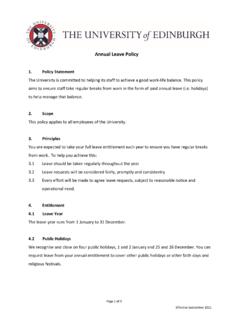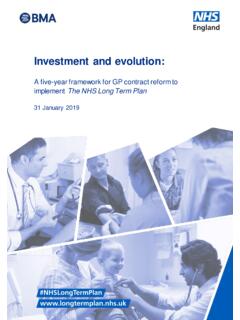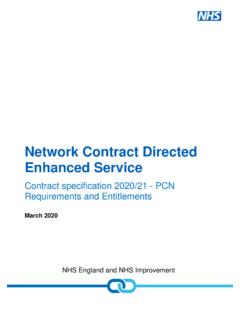Transcription of Early years entitlements: local authority funding of providers
1 Early years entitlements: local authority funding of providers operational guide 2021 to 2022 December 2020 2 1 Contents 1. Introduction 4 Who is this publication for? 4 Related guidance 4 Monitoring and compliance 5 2. The Early years national funding formula (EYNFF) 6 3. Changes for 2021 to 2022 7 4. local authority funding of the entitlement for disadvantaged 2- year -olds 8 5. local authority funding of the entitlements for 3 and 4- year -olds 9 Single rate for both entitlements 9 95% pass-through requirement 9 What is included within 95% pass-through 9 Remaining 5% expenditure 9 What is not included within pass-through 10 Monitoring compliance with the 95% pass-through requirement 11 Disapplications from the 95% pass-through requirement 13 6.
2 Setting a local formula 15 funding factors 15 Universal base rate 15 funding supplements 15 Additional funding for maintained nursery schools (MNS) 17 Special educational needs inclusion fund 18 Eligibility 18 Value 18 Sources of funding 18 Allocation of funding 19 Eligible providers 19 Compliance 19 7. Disability access fund (DAF) 20 Eligibility 20 3 Identifying eligible children 20 Eligibility checking 20 Distributing DAF to Early years providers 20 Timing of payments 21 8. Early years pupil premium (EYPP) 22 Eligibility 22 Identifying eligible children 22 Eligibility checking 23 Assessing eligibility for parents in receipt of Universal Credit 23 Paying EYPP to Early years providers 25 9.
3 Further information 27 4 1. Introduction Who is this publication for? This guide is for: local authorities Early years providers other Early years stakeholders who may find it useful local authorities should follow this guidance when funding providers to deliver the Early years entitlements in the financial year 2021 to 2022. The Department for Education (DfE) provides local authorities with 6 relevant funding streams which together form the Early years block of the dedicated schools grant (DSG).
4 They are: the 15 hours entitlement for disadvantaged 2- year -olds the universal 15 hours entitlement for all 3 and 4- year -olds the additional 15 hours entitlement for eligible working parents of 3 and 4-yearolds the Early years pupil premium (EYPP) the disability access fund (DAF) maintained nursery school (MNS) supplementary funding Some of the rules and principles described in this guide will be set out in secondary legislation. This guide is intended to help local authorities to fund Early years providers to deliver the Early years entitlements.
5 It is not intended to cover the way in which the DfE funds local authorities themselves, as this is set out separately. Details of local authority initial funding allocations for the Early years funding block in 2021 to 2022 will be published in December 2020 alongside a technical note. Related guidance The DfE has also provided further guidance relevant to the funding of the Early years entitlements. Early years funding arrangements during coronavirus (COVID-19). Early education and childcare: statutory guidance Early education and childcare: operational guidance High needs operational guidance 5 Schools forums operational and good practice guide Monitoring and compliance We will use the planned budget information provided by local authorities in their annual section 251 Early years proforma to monitor compliance with all the policies set out in this guide and the underpinning regulations.
6 We will use the Early years funding benchmarking tool to publish information about local authority compliance. 6 2. The Early years national funding formula (EYNFF) Since its introduction in April 2017, the EYNFF has set the hourly funding rates that each local authority is paid to deliver the universal and additional entitlements for 3 and 4-yearolds. There is a separate formula that sets the hourly funding rates for 2- year -olds. The 2- year -old and 3 and 4- year -old hourly funding rates for 2021 to 2022 for all local authorities can be found on the Early years funding : 2021 to 2022 page on 7 3.
7 Changes for 2021 to 2022 The main changes from the requirements for the 2020 to 2021 financial year are: In section on page 17, first paragraph: clarification of continuation of supplementary funding for MNS for the financial year 2021 to 2022. Also in section on page 17, third paragraph: additional information about the publication of indicative and conditional supplementary funding allocations for MNS. 8 4. local authority funding of the entitlement for disadvantaged 2- year -olds There are a number of differences between how local authorities should fund the entitlement for disadvantaged 2- year -olds, compared to the entitlements for 3 and 4-yearolds.
8 First, unlike 3 and 4- year -olds, there is currently no regulatory requirement to pass through a set amount of the government s funding to providers for delivery of the 2-yearold entitlements. This is because data from local authorities planned budgets (via section 251) shows that the vast majority of the government s funding is already being passed through to providers . We expect this to continue, as it is important that the government funding reaches providers in order to deliver 2- year -old places, and we will continue to monitor any 2- year -old central spend in future years .
9 Secondly, there are no compulsory supplements for 2- year -olds, and local authorities are encouraged to fund providers on the basis of a flat hourly base rate for all providers . Finally, local authorities are not required to establish a special educational needs inclusion fund (SENIF) for 2- year -olds. However, they may wish to do so as part of their provision for children with special educational needs (SEN). 9 5. local authority funding of the entitlements for 3 and 4- year -olds Single rate for both entitlements The DfE funds local authorities on the same basis for both the universal 15 hours entitlement and the additional 15 hours entitlement for working parents.
10 This is because the statutory framework and the quality requirements for the 2 entitlements are the same. We therefore expect local authorities to fund their providers in the same way for both sets of hours and not to distinguish between the two. This means using the same hourly base rate and same supplements for both entitlements. 95% pass-through requirement local authorities are required to plan to pass-through 95% of their 3 and-4- year -old funding from the government to Early years providers . This pass-through requirement ensures that the vast majority of government funding reaches providers so that they can deliver the government s free entitlements.















